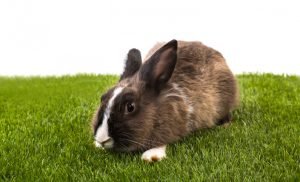Have you ever wondered, “How fast can a bunny rabbit run?” These seemingly innocent creatures can display impressive speeds, leaving many to marvel at their agility and grace. In this blog post, we’ll dive into the world of rabbit speed, exploring the mechanics behind their rapid movement, and comparing their capabilities to other animals. Are you ready to discover the speed secrets of these adorable creatures? Let’s hop right in!
Key Takeaways
Witness incredible speeds of up to 45 mph in wild and domestic rabbits!
Explore breed, size, age & motivation affecting speed potential.
Ensure a healthy lifestyle with daily exercise for your pet bunny – playtime & stimulation is essential!
The Mechanics of Rabbit Speed

When it comes to wild cottontail rabbits and domestic rabbits, their ability to reach impressive speeds is truly fascinating. Although small and fluffy, rabbits possess unique physical characteristics that allow them to swiftly evade predators and navigate their environment with ease. Their long, powerful hind legs propel them forward with great force, while their lightweight bodies enable them to remain agile in the process.
Rabbits employ a hopping motion that significantly contributes to their high-speed capabilities. Their hind legs are longer than their front legs and contain fast-twitch muscle fibers, contributing to the rapid propulsion they exhibit when running. Additionally, rabbits possess digitigrade locomotion, moving on only their toes, which allows them to move quickly and efficiently, further enhancing their ability to evade predators.
Hopping vs. Running
Rabbits are unique in that they hop instead of run, propelling themselves forward by pushing both feet off the ground at the same time and landing on their front paws one after the other. This hopping motion generates momentum, allowing them to reach top speeds of up to 35 miles per hour in some species! Can you imagine watching a rabbit outrun a human? It’s truly an incredible sight to behold.
The combination of a rabbit’s small size and agility, making them elusive, presents a significant survival advantage in the wild. Their front paws play a vital role in creating velocity, enabling rabbits to move similarly to cheetahs, one of the fastest land animals on the planet. Who knew these cute little creatures had so much in common with such powerful predators?
The Power of Hind Legs
The key to a rabbit’s speed is its hind legs. These long, powerful limbs allow rabbits to leap great distances and reach high speeds, making them formidable opponents for any predator. The length of a rabbit’s hind legs can greatly impact its speed, with longer legs generally leading to faster speeds.
In addition to their speed, rabbits can also use their rabbit’s hind legs as a weapon for self-defense. When threatened, a rabbit can deliver a powerful kick with its back legs, potentially injuring or even killing smaller predators. It’s no wonder these speedy animals have managed to survive and thrive in the wild, despite being prey for many larger creatures.
Factors Affecting Rabbit Speed

Despite their reputation for speed, a rabbit’s ability to reach top speeds can be influenced by various factors. These factors include breed, individual characteristics, and environment. For example, the European rabbit and the Jackrabbit breeds are considered some of the fastest rabbit species, with top speeds of up to 45 mph.
Bear in mind, that the speed potential varies among different rabbit breeds. Different rabbit breeds have varying speed potentials, and even within a single breed, individual rabbits can display differing degrees of agility.
In the next sections, we’ll explore how factors such as:
Breed
Size
Age
Health
Motivation
A rabbit’s speed is impressive, and many people wonder how fast can a rabbit go. Various factors, such as slow twitch muscle fibers, can impact a rabbit’s speed, making it a fascinating topic to explore.
Breed Differences
The breed of a rabbit significantly determines its potential speed. Some breeds, such as the European rabbit and the Jackrabbit, are naturally faster than others, reaching speeds of up to 45 mph. The Belgian Hare, another fast rabbit breed, is also known for its incredible speed.
Remember, individual variations within a breed can also affect a rabbit’s running ability. Factors such as genetics, upbringing, and overall health can all contribute to the differences observed among rabbits of the same breed. Regardless, knowing the general speed potential of a particular breed can be helpful when selecting a pet rabbit or participating in rabbit racing events.
Size and Agility
A rabbit’s size can significantly influence its speed. Generally, smaller rabbits tend to be faster and more agile compared to larger rabbits due to their lighter bodies and longer limbs, which allow them to move quickly and change direction easily. On the other hand, larger rabbits may have more muscle mass, making them slower but more powerful in their movements.
However, remember that factors such as diet and overall health can also influence the impact of body weight on speed and agility. A well-rounded diet and proper care can ensure that your rabbit maintains a healthy weight, ultimately contributing to its speed and agility.
Age and Health
A rabbit’s speed is also significantly influenced by its age and health. Younger, healthier rabbits can run faster than older or injured rabbits. As rabbits age, their speed may not change significantly, but factors such as joint health and muscle strength can diminish, potentially impacting their ability to run as fast as they once did.
Injuries and health conditions can also greatly affect a rabbit’s speed and agility. When injured, a rabbit may experience pain, reduced mobility, and decreased muscle strength, all of which can seriously impact its ability to run and move quickly. Providing proper care and treatment for injured rabbits is crucial to ensure their recovery and maintain their speed and agility.
Motivation
Encountering predators, proper training, and the desire for rewards are just a few ways that can motivate rabbits to run faster. In the wild, the presence of a predator can dramatically increase a rabbit’s speed, triggering a threat response that enables them to quickly escape potential danger.
For pet rabbits, motivation can come in the form of positive reinforcement, such as affectionate petting, words, and tone of voice, as well as small treats used as rewards. Understanding what motivates your rabbit and creating an exciting space for exercise can help your pet rabbit run faster and maintain a healthy, active lifestyle.
Comparing Wild and Domestic Rabbit Speeds

Now that we’ve explored the factors that contribute to a rabbit’s speed, let’s take a closer look at the differences between wild and domestic rabbits. Wild rabbits, like the European rabbit, can reach top speeds of 45 mph, while domestic rabbits typically run at speeds between 25 and 35 mph. This difference in speed can be attributed to the fact that wild rabbits have a greater need to run fast as they constantly face natural predators and must remain vigilant to survive.
In contrast, domesticated rabbits, bred for purposes like companionship and show, may have slightly slower speeds than their wild counterparts in some breeds. Despite this difference, domestic rabbits still possess impressive speeds and agility, making them fascinating pets and captivating companions.
Wild Rabbit Speeds
Wild rabbits, such as the European rabbits and the Jackrabbit, can reach incredible speeds of up to 45 mph, depending on the breed and environment. These high speeds are a result of their constant need to escape predators and navigate their natural habitats.
In addition to their speed, wild rabbits also possess incredible agility, allowing them to perform sharp turns and evade predators with ease. These survival skills, combined with their lightning-fast speeds, make wild rabbits a formidable prey species in the animal kingdom.
Domestic Rabbit Speeds
Domestic rabbits, while not quite as fast as their wild counterparts, are still impressively speedy animals. They can run at speeds between 25 and 35 mph, with some breeds being faster than others. The slightly slower speeds of domestic rabbits can be attributed to their domesticated nature and the various purposes for which they have been bred, such as companionship, show, and even meat production.
Despite their domestication, pet rabbits still require ample opportunities for exercise and mental stimulation to maintain their speed and agility. Providing a safe and engaging environment for your pet rabbit to explore and exercise is essential for their overall health and well-being.
Rabbit Speed in Relation to Other Animals

Given their remarkable speed, rabbits are frequently compared with other animals in terms of running abilities. Domestic rabbits can run faster than humans, with top speeds of up to 35 mph, while the average running speed of a human falls between 5 and 12 mph. However, rabbits are not the fastest land animal, as that title goes to the cheetah, with a recorded top speed of about 70 mph.
Even when compared to common predators like coyotes and lions, rabbits can still hold their own. Coyotes can run at speeds up to 43 mph, while lions can reach an incredible top speed of 50 mph. Although rabbits may not always outrun their predators, their agility and rapid acceleration give them a fighting chance at survival.
Rabbits vs. Humans
Rabbits truly outshine humans when it comes to speed. As mentioned earlier, domestic rabbits can reach speeds of up to 35 mph, which is considerably faster than the average human running speed of 5 to 12 mph. This impressive speed advantage allows rabbits to:
Evade capture
Escape danger
Outrun predators
Navigate their environment quickly
More effectively than humans could in similar situations, slow twitch muscle fibers play a role.
The physical features of rabbits, such as their muscled hind legs and lightweight bodies, contribute to their incredible speed and agility. These evolutionary adaptations have enabled rabbits to elude predators and thrive in various environments, making them a fascinating species to observe and study.
Rabbits vs. Predators
While rabbits are fast, they are not invincible when it comes to their natural predators. Some common predators of rabbits include:
Wolves
Coyotes
Birds of prey
Stoats
Dogs
Ferrets
Rabbits can run at speeds of up to 30 mph, with some hares reaching speeds of 45 mph, which is incredibly fast compared to many of their common predators. This is why rabbits run so efficiently in the wild.
However, rabbits still need to employ various strategies to escape from predators and survive in the wild. Some tactics rabbits use to evade their predators include:
Sprinting
Avoiding open spaces
Performing sharp turns
Squeezing into small spaces
Despite their speed, rabbits must constantly rely on their agility and wit to outsmart and outrun their natural enemies.
Ensuring a Healthy and Active Lifestyle for Pet Rabbits

Maintaining a healthy and active lifestyle for pet rabbits is essential for their happiness and overall well-being. Integrating exercise, playtime, and mental stimulation into a rabbit’s daily routine is crucial, and providing a variety of activities can keep them engaged and healthy. Regular exercise not only helps maintain their speed and agility but also contributes to their overall physical and mental health.
Faster rabbit breeds may require more activity to maintain their optimal condition. It’s essential to consider the specific needs of your rabbit’s breed when planning their exercise routine, as well as taking into account their individual personality and preferences. A happy, healthy rabbit is an active and fast rabbit!
Exercise Requirements
All rabbits require regular exercise to maintain good health, with faster breeds needing even more activity to stay in top shape. Rabbits benefit from various types of exercise, including:
running
jumping
climbing
digging
These activities can be encouraged by providing them with ramps, boxes, and toys.
It is recommended to give rabbits at least 3-4 hours of exercise daily, which can be achieved through a combination of free-range time and structured play sessions. Providing a safe and engaging environment for your rabbit to explore and exercise is essential to ensure their overall health and happiness.
Playtime and Stimulation
Offering a range of play options and mentally stimulating activities is crucial for maintaining the happiness and health of pet rabbits. Some examples of exercise options for rabbits include:
Ramps to run on
Buckets of hay to jump in
Boxes to climb on
Rabbit tunnels are made out of cardboard tubes to encourage running and exploration.
These activities can help keep your rabbit active and engaged.
Toys that allow digging and scent marking, as well as positive interactions with humans through grooming and training, can also enrich a rabbit’s life and provide mental stimulation. Creating a varied and stimulating environment, offering treats for your rabbit to find, and providing opportunities for exercise and social interaction are all effective ways to keep your pet rabbit engaged and active.
Summary
In conclusion, rabbit speed is a fascinating topic that showcases the incredible abilities of these adorable creatures. From the mechanics of their hopping movement to the various factors that contribute to their speed, rabbits are truly remarkable animals. Whether you have a pet rabbit or simply admire these agile creatures from afar, understanding the secrets behind their speed can provide a greater appreciation for their unique adaptations and survival skills. So the next time you see a rabbit sprinting across a field, take a moment to marvel at the amazing speed of these furry little wonders.
Frequently Asked Questions
Does rabbit run very fast?
Yes, rabbits can run incredibly fast – up to 45 mph! It’s definitely faster than most of us humans can run.
Who is faster bunny or cat?
Wow, rabbits can run up to 45 mph – that’s even faster than most house cats! You’d be amazed at how speedy these bunnies can be. So it’s safe to say, that when it comes to speed, the bunny definitely beats the cat.
Is A rabbit faster than a dog?
Dogs are significantly faster than rabbits, with some domestic breeds being able to run up to 45 miles per hour! Rabbits can generally only reach speeds of about 30 miles per hour.
What is the top speed of a domestic rabbit?
Domestic rabbits can run up to 35 mph, making them incredibly swift and agile!
How do wild rabbit speeds compare to domestic rabbit speeds?
Wild rabbits are significantly faster than domestic rabbits, reaching speeds of up to 45 mph compared to the 25-35 mph of their domesticated counterparts.



